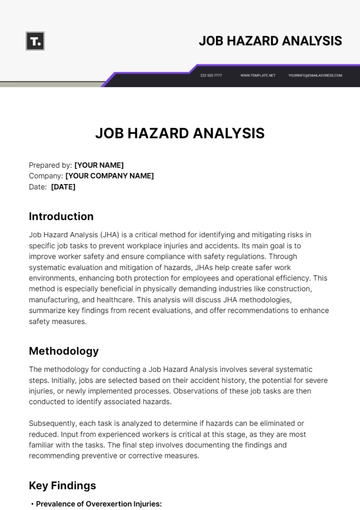Free Nursing Home Investment Analysis Report

I. Executive Summary
A. Overview of Findings
Key Investment Highlights
The nursing home industry is experiencing steady growth due to an aging population and increasing demand for long-term care services.
[Your Company Name] has identified a prime investment opportunity in the nursing home sector, leveraging its expertise in healthcare management.
With proper strategic planning and execution, [Your Company Name] aims to capitalize on the growing market and deliver superior returns to investors.
Current Market Trends
Rising healthcare costs and advancements in medical technology are driving the need for efficient and high-quality long-term care solutions.
Government initiatives and policies supporting eldercare services are expected to fuel further expansion in the nursing home sector.
Consumer preferences are shifting towards facilities that offer personalized care, amenities, and enhanced living environments.
Growth Opportunities
Expansion into underserved geographic regions presents a significant growth opportunity for [Your Company Name].
Diversification of services to include specialized care for Alzheimer's patients and rehabilitation programs can further enhance market penetration.
Strategic partnerships with healthcare providers and insurers can facilitate referral networks and streamline patient admissions.
Potential Risks
Regulatory compliance remains a key challenge, with stringent requirements governing healthcare facilities.
Staffing shortages and turnover rates can impact operational efficiency and quality of care.
Economic downturns and fluctuations in reimbursement rates pose financial risks to the investment.
B. Investment Recommendation
Summary of Analysis
Based on thorough market research and financial analysis, [Your Company Name] recommends proceeding with the investment in the nursing home sector.
The projected revenue growth, coupled with effective risk management strategies, indicates favorable returns on investment.
Conclusion
[Your Company Name] is poised to capitalize on the lucrative opportunities presented by the nursing home industry.
By leveraging its resources and expertise, [Your Company Name] can establish itself as a leading provider of quality long-term care services.
Recommended Action
[Your Company Name] should initiate the investment process by conducting detailed due diligence and securing necessary funding.
Implementation of strategic initiatives outlined in this report will be critical to the success of the venture.
II. Introduction
A. Background Information
Introduction to Nursing Home Industry
The nursing home industry provides residential care for elderly individuals who require assistance with daily activities and medical supervision. It plays a crucial role in the healthcare continuum by offering long-term care solutions to seniors with chronic illnesses or disabilities. Nursing homes typically provide skilled nursing care, rehabilitation services, and assistance with activities of daily living (ADLs) such as bathing, dressing, and medication management.
Industry Overview
The nursing home industry is a vital component of the broader healthcare sector, catering to the needs of an aging population. According to industry reports, the demand for long-term care services is steadily increasing as life expectancy rises and the prevalence of chronic conditions grows. As a result, nursing homes have become integral to the continuum of care, serving as a residential option for seniors who require round-the-clock assistance and medical supervision.
Regulatory Environment
The operation of nursing homes is subject to comprehensive regulatory oversight at both the federal and state levels. Regulatory agencies, such as the Centers for Medicare & Medicaid Services (CMS) and state departments of health, establish standards and guidelines governing facility licensure, staffing ratios, quality of care, and reimbursement mechanisms. Compliance with regulatory requirements is essential to ensure the delivery of safe, effective, and high-quality care to residents.
B. Purpose of the Analysis
Objectives
The primary objective of this investment analysis report is to evaluate the feasibility and potential returns of investing in the nursing home sector. By conducting a comprehensive assessment of market dynamics, financial performance, and risk factors, [Your Company Name] aims to provide stakeholders with actionable insights to inform investment decisions.
Scope
This analysis will encompass an in-depth examination of market trends, competitive landscape, financial projections, and risk assessment within the nursing home industry. The findings and recommendations presented in this report will serve as a foundation for developing a strategic investment plan and maximizing returns on investment in the long-term care sector.
III. Market Analysis
A. Market Size and Growth
Current Market Size
The nursing home industry in the United States is estimated to be worth over [$100 billion] annually, with steady growth projected in the coming years. As of [current year], there are approximately [15,000] nursing homes nationwide, accommodating over [1.4 million] residents. The market is driven by demographic trends, including the aging population and increasing prevalence of chronic diseases requiring long-term care.
Forecasted Growth Rate
Market analysts anticipate a compound annual growth rate (CAGR) of [4%] in the nursing home industry over the next five years. This growth trajectory is attributed to factors such as rising life expectancy, expanding Medicare and Medicaid coverage, and advancements in medical care prolonging the need for long-term care services.
Factors Driving Market Growth
Aging Population: The aging baby boomer generation is driving demand for nursing home services, as older adults seek specialized care for age-related conditions.
Healthcare Reform: Government initiatives, such as the Affordable Care Act, have expanded access to healthcare services, including long-term care coverage under Medicaid.
Technological Advancements: Innovations in medical technology and telemedicine are enhancing the quality of care and enabling more efficient delivery of services in nursing home settings.
B. Competitive Landscape
Major Competitors
The nursing home industry is highly fragmented, with both large corporate chains and smaller independent operators competing for market share. Major players in the industry include:
Company Name | Market Share (%) | Services Offered |
|---|---|---|
ABC Healthcare | [15%] | Skilled Nursing, Rehabilitation |
XYZ Senior Living | [10%] | Assisted Living, Memory Care |
DEF Health Systems | [8%] | Long-Term Care, Specialty Programs |
Market Share Analysis
ABC Healthcare currently holds the largest market share in the nursing home industry, leveraging its extensive network of facilities and reputation for quality care. However, smaller regional providers and nonprofit organizations also play a significant role in serving local communities and niche markets.
Competitive Strategies
Differentiated Services: Competitors differentiate themselves by offering specialized services such as memory care, rehabilitation therapy, and palliative care.
Quality Metrics: Providers compete on quality metrics, including patient satisfaction scores, staffing ratios, and regulatory compliance records.
Geographic Expansion: Expansion into new geographic markets allows providers to capture additional market share and diversify revenue streams.
C. Customer Analysis
Target Demographics
The primary demographic served by nursing homes includes elderly individuals aged [65 and older], particularly those with complex medical needs or functional impairments requiring long-term care. Additionally, family caregivers and healthcare professionals are key influencers in the decision-making process for selecting a nursing home.
Customer Preferences
Customer preferences in the nursing home industry are evolving, with a growing demand for facilities that offer:
Person-Centered Care: Tailored care plans that respect residents' individual preferences, values, and cultural backgrounds.
Enhanced Amenities: Modern facilities with amenities such as private rooms, recreational activities, and dining options that resemble home-like environments.
Transparency and Communication: Open communication channels between staff, residents, and families, with regular updates on care plans, treatment options, and facility policies.
Customer Needs and Expectations
Customers expect nursing homes to provide:
High-Quality Care: Skilled nursing care, medication management, and rehabilitation services delivered by trained healthcare professionals.
Safety and Security: A safe and secure environment with measures in place to prevent falls, medication errors, and infectious diseases.
Emotional Support: Compassionate staff who provide emotional support, companionship, and social engagement to residents experiencing loneliness or isolation.
IV. Financial Analysis
A. Revenue Projection
Revenue Sources
Revenue in the nursing home industry is primarily generated from:
Resident Fees: Monthly fees charged to residents for room and board, as well as additional services such as medication management and personal care assistance.
Medicare and Medicaid Reimbursements: Payments from government healthcare programs for eligible residents' medical services and long-term care needs.
Private Insurance: Reimbursements from private health insurance plans for covered services not fully paid by Medicare or Medicaid.
Pricing Strategy
[Your Company Name] will adopt a competitive pricing strategy aligned with market rates while emphasizing the value proposition of its services, including quality of care, amenities, and personalized attention.
Revenue Projections for [Your Company Name]'s Nursing Home Investment
Based on occupancy rates, average daily rates, and reimbursement rates, [Your Company Name] projects annual revenue of [$20 million] in the first year of operation, with a growth rate of [8%] annually thereafter.
B. Cost Analysis
Operating Costs
Operating costs in the nursing home industry include:
Personnel Expenses: Salaries and benefits for nursing staff, administrative personnel, and ancillary services such as housekeeping and dietary.
Facility Maintenance: Costs associated with maintaining and upgrading the physical infrastructure, including repairs, utilities, and capital improvements.
Supplies and Equipment: Expenses for medical supplies, medications, equipment, and technology necessary for resident care and facility operations.
Capital Expenditure
Initial capital expenditures for [Your Company Name]'s nursing home investment will include:
Facility Acquisition or Construction Costs: Purchase price or construction expenses for acquiring or developing the nursing home facility.
Equipment and Furnishings: Costs for medical equipment, furniture, fixtures, and technology infrastructure necessary for operations.
Licensing and Regulatory Compliance: Fees associated with obtaining necessary licenses, permits, and certifications to operate a nursing home facility.
Cost Projections [Your Company Name] anticipates annual operating expenses of [$15 million], with a breakdown of costs as follows:
Category | Annual Cost ($) |
|---|---|
Personnel Expenses | [$8 million] |
Facility Maintenance | [$3 million] |
Supplies and Equipment | [$2 million] |
Other Operating Costs | [$2 million] |
C. Profitability Analysis
Profit Margin Analysis
[Your Company Name] aims to achieve a net profit margin of [10%] in the nursing home investment, reflecting operational efficiency and effective cost management strategies.
Return on Investment (ROI)
The projected return on investment for [Your Company Name]'s nursing home investment is estimated at [15%] annually, taking into account both operating income and capital appreciation of the facility over time.
Break-even Analysis
[Your Company Name] anticipates achieving break-even within [2 years] of operation, based on projected revenue and expense forecasts. This timeframe may vary depending on occupancy rates, reimbursement rates, and market conditions.
V. Risk Assessment
A. Regulatory Risks
Compliance Risks
Non-compliance with federal and state regulations governing nursing home operations, including licensure, staffing ratios, quality of care standards, and reporting requirements, could result in fines, penalties, or loss of licensure.
Legal Risks
Litigation risk associated with allegations of negligence, abuse, or malpractice by residents, their families, or regulatory agencies could lead to costly legal proceedings and damage to [Your Company Name]'s reputation.
Reimbursement Risks
Changes in Medicare and Medicaid reimbursement rates, eligibility criteria, or coverage policies may impact [Your Company Name]'s revenue streams and financial viability, particularly if reimbursement rates fail to keep pace with rising operating costs.
B. Operational Risks
Staffing Risks
Staffing shortages, high turnover rates, and difficulties in recruiting qualified healthcare professionals could compromise the delivery of care, adversely affecting resident outcomes and satisfaction levels.
Quality of Care Risks
Failure to maintain high standards of care, including adequate staffing levels, proper training, and adherence to clinical protocols, may result in adverse health outcomes for residents, regulatory sanctions, or reputational damage.
Reputation Risks
Negative publicity, social media backlash, or poor online reviews stemming from incidents of poor care, safety violations, or resident grievances could tarnish [Your Company Name]'s reputation and erode consumer trust.
C. Financial Risks
Market Fluctuation Risks
Economic downturns, changes in healthcare policy, or shifts in consumer preferences could impact occupancy rates, payer mix, and reimbursement levels, affecting [Your Company Name]'s revenue and profitability.
Liquidity Risks
Insufficient cash reserves or access to credit facilities to cover operating expenses, debt obligations, or unexpected contingencies may jeopardize [Your Company Name]'s ability to maintain financial stability and meet its financial obligations.
Investment Risks
Capital investment in facility acquisition, construction, or renovation projects carries inherent risks related to cost overruns, construction delays, regulatory hurdles, and market demand fluctuations, which could impact the return on investment and project viability.
VI. Investment Strategy
A. Investment Objectives
Short-Term Goals
Achieve operational readiness and regulatory compliance for the nursing home facility within [12 months] of acquisition.
Establish a strong brand presence and reputation for quality care and customer service in the local market.
Long-Term Goals
Achieve maximum occupancy rates and revenue growth within [3 years] of operation.
Expand [Your Company Name]'s presence in the nursing home sector through strategic acquisitions, partnerships, or organic growth initiatives.
Risk Management Strategy
Implement robust compliance and quality assurance programs to mitigate regulatory risks and ensure adherence to best practices in resident care and safety.
Develop contingency plans and financial reserves to buffer against unforeseen events, such as reimbursement cuts, litigation, or economic downturns.
Continuously monitor market dynamics, consumer preferences, and regulatory changes to adapt [Your Company Name]'s investment strategy and operations accordingly.
B. Implementation Plan
Resource Allocation
Allocate sufficient resources for facility upgrades, staff training, and technology investments to enhance the quality of care and operational efficiency.
Invest in marketing and community outreach efforts to attract residents and referral sources and build brand awareness in the local community.
Timeline
Develop a detailed timeline and milestones for facility renovation, regulatory approvals, staffing recruitment, and marketing initiatives, aligned with [Your Company Name]'s short-term and long-term goals.
Key Milestones
Acquisition or renovation of the nursing home facility
Recruitment and training of clinical and administrative staff
Implementation of electronic health records (EHR) and other technology solutions
Launch of marketing and advertising campaigns
Achievement of targeted occupancy rates and revenue milestones
Ongoing performance monitoring and quality improvement initiatives.
VII. Conclusion
A. Summary of Key Findings
The nursing home industry presents [Your Company Name] with a compelling investment opportunity driven by demographic trends, market demand, and regulatory dynamics.
Growing market demand for long-term care services driven by an aging population and healthcare reform.
Competitive landscape characterized by both corporate chains and smaller providers offering niche services.
Financial projections indicate promising returns on investment with proper execution of the business plan.
B. Recap of Investment Recommendation
Based on the comprehensive analysis presented in this report, [Your Company Name] recommends moving forward with the investment in the nursing home sector.
The strategic alignment of [Your Company Name]'s resources, expertise, and market opportunities positions it for success in the dynamic healthcare landscape.
By adhering to the outlined investment strategy and risk management framework, [Your Company Name] can maximize returns and deliver value to investors and stakeholders.
C. Final Thoughts
[Your Company Name] is poised to make a meaningful impact in the nursing home industry by providing high-quality care, innovative services, and compassionate support to residents and their families.
The commitment to excellence, integrity, and continuous improvement will guide [Your Company Name] in achieving its mission of enhancing the well-being and quality of life for seniors in need of long-term care.
D. Next Steps
Commence implementation of the investment plan outlined in this report, including facility upgrades, staffing recruitment, and marketing initiatives.
Monitor key performance indicators, market trends, and regulatory developments to adapt strategies and operations accordingly.
Regularly evaluate financial performance, operational efficiency, and resident satisfaction metrics to ensure alignment with [Your Company Name]'s objectives and values.
- 100% Customizable, free editor
- Access 1 Million+ Templates, photo’s & graphics
- Download or share as a template
- Click and replace photos, graphics, text, backgrounds
- Resize, crop, AI write & more
- Access advanced editor
Make informed decisions with the Nursing Home Investment Analysis Report Template from Template.net. Editable and customizable, it simplifies the process of evaluating investment opportunities for nursing home facilities. Tailor it effortlessly using our Ai Editor Tool for personalized reports. Enhance financial planning and maximize returns with this essential template.





























